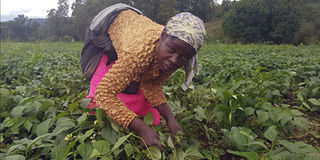Beans rich in iron boost attention span in women - study

Workers pick French beans at Paul Ng'ang'a's farm in Uasin Gishu.PHOTO|FILE
What you need to know:
- For almost five years now, scientists in African research institutions have been developing iron rich hybrid bean seeds by crossing varieties that are rich in iron with those that adapt well in different ecological zones.
- Various countries have already released different hybrids to farmers with the Kenya Agricultural and Livestock Research Organisation (Kalro) officially releasing the first four iron rich hybrid bean varieties in May.
When scientists started breeding bio-fortified crops in Kenya and all over Africa some 10 years ago, the main aim was to increase the nutritional value of common staples, thus, fighting malnutrition which has crippled the continent.
However, a recent study conducted in Rwanda shows that eating beans bred to contain higher iron can boost memory and attention span in women of reproductive age.
“This is the first scientific evidence we have that iron bio-fortified beans can improve cognition in women during this critical phase of their lives,” said Dr Laura Murray-Kolb, the lead researcher and a nutritional expert from the US-based Pennsylvania State University.
Bio-fortification increases staple crop nutrient concentration without sacrificing agronomic traits such as yield, pest resistance and drought tolerance among others.
For almost five years now, scientists in African research institutions have been developing iron rich hybrid bean seeds by crossing varieties that are rich in iron with those that adapt well in different ecological zones.
Various countries have already released different hybrids to farmers with the Kenya Agricultural and Livestock Research Organisation (Kalro) officially releasing the first four iron rich hybrid bean varieties in May.
These are Nyota, a drought tolerant variety while Angaza, Metameta and Faida are for medium and high potential areas.
The seeds are being multiplied currently to boost stocks, though one can find them only at Kalro, Katumani.
To develop the hybrids, best parent varieties that are rich in iron are first identified. Pollen is then collected manually from the bean flowers and introduced to those that are highly adapted to given ecological zone. The result is a hybrid variety that is iron rich with all other desired agronomical traits. The hybrids are then multiplied and sold to farmers as seed.
During the Rwandan study, 150 female students from the University of Rwanda aged between 18 and 27 were assigned to eat 336g wet beans per day in two meals (168g per meal) for 18 weeks. The beans are staple in Rwanda, what maize is to Kenya.
Half of them ate only bio-fortified beans that had been bred to contain more iron, while the other half ate normal beans with lower iron content.
The women were later subjected to Electroencephalography (EEG) test, which is a physiological monitoring method to record electrical activity of the brain – as a way of measuring their attention span and cognition.
Consequently, the women who ate bio-fortified beans were found to have better memory recall speed and efficiency than those who consumed conventional beans.
“Our work highlights that iron deficiency may disadvantage young women in their academic prospects and careers. Without addressing malnutrition, we cannot expect our people and economies to reach their full potential,” said Dr Mercy Lung’aho, a nutritionist at the International Center for Tropical Agriculture (CIAT), and one of the researchers.
David Karanja, the bean team leader at Kalro, said it may not be easy to differentiate the iron rich beans from the low iron beans just by looking at them. But before any hybrid variety is released in Kenya for example, they must be assessed by the Kenya Plant Health Inspectorate Service distinctiveness, uniformity and stability.
“The new variety must have something that is different from all other existing ones. The grain may look the same, but there could be a difference in the colour of flowers or the shape of the leaves,” said Karanja.
Beans are one of the most important versatile super-food staples consumed world over, and are the next-highest source of protein after animal-based foods. They are also low in fat, high in fibre and nutrients, and are usually affordable.
Dr Steve Beebe, leader of CIAT’s bean research programme, said there is need to streamline such high iron bean solutions into policy frameworks to address healthier diets.
“We need firm policy action to advocate for food systems that include foods improved for their nutritional value,” he said.





